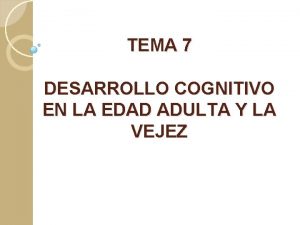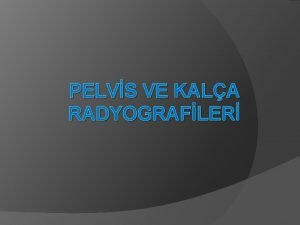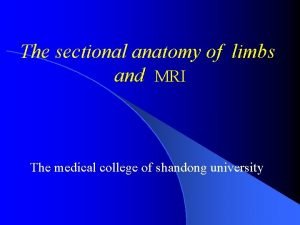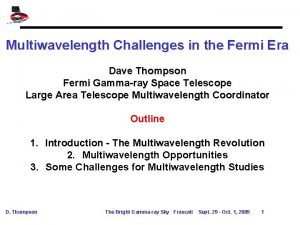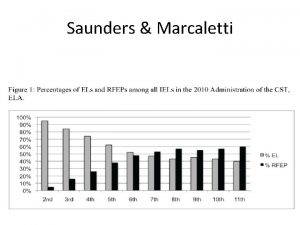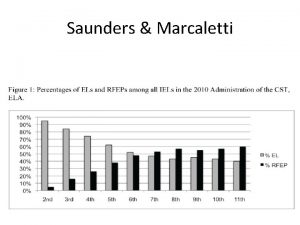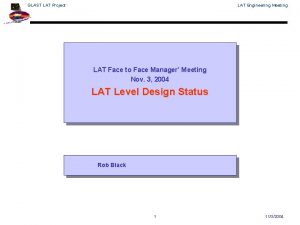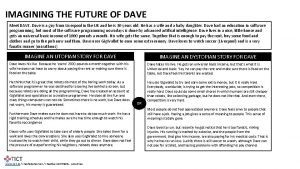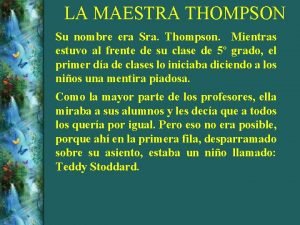Update on Multiwavelength Needs Dave Thompson LAT Multiwavelength








- Slides: 8

Update on Multiwavelength Needs Dave Thompson LAT Multiwavelength Coordinator D. Thompson GLAST LAT Collaboration Meeting Aug. 31, 2005 1

Presented Last Year. What is new? GLAST LAT Multiwavelength Studies Needs and Resources Report of the Ad Hoc Multiwavelength Observation Planning Group Roger Blandford, Co-chair Dave Thompson, Co-chair Seth Digel Greg Madejski Roger Romani Steve Thorsett http: //www-glast. slac. stanford. edu/GLAST_Collaboration. SEP 04/MW_committee_report_public. pdf D. Thompson GLAST LAT Collaboration Meeting Aug. 31, 2005 2

The Te. V Connection • Identified contacts with the major Cerenkov telescope groups: ØH. E. S. S. – Wagner, Puehlhofer ØMagic – de Angelis ØVERITAS – Krawczynski, Ong ØCANGAROO – Kubo • Met with VERITAS group in Nov. 2004. , plus other meetings. • Watched the exciting results come in from H. E. S. S. • Julie Mc. Enery has started a discussion group for LAT-Te. V interests. Their Confluence Web page is http: //confluence. slac. stanford. edu/display/GLAMCOG/The+Te. V+Connection D. Thompson GLAST LAT Collaboration Meeting Aug. 31, 2005 3

Essential – Prioritized List of MW Needs • Why? Because any multiwavelength effort involves some resources – time, money, people, planning. • A challenge for each of the LAT science groups is to help define these MW priorities. • Assignment – each science group provide a prioritized list of MW needs, including justification, specific examples, and some estimate of what resources LAT will have to provide. Goal – end of September. • Corollary – we all need to explore ways to tap other resources. Possibilities – NSF’s Major Research Instrumentation Program or Program for Research and Education with Small Telescopes. The Italian government has provided some MW support. Perhaps approach the Astronomy and Astrophysics Advisory Committee. D. Thompson GLAST LAT Collaboration Meeting Aug. 31, 2005 4

Need #2 – Identification of MW Facilities for LAT • Why? MW planning depends on having contacts and agreements in place. MW efforts are needed before launch, as well as monitoring, follow-up, contemporaneous, and simultaneous observations during the mission. • Assignment – each science group start collecting information about available MW facilities, using the spreadsheet model distributed last weekend. Information includes science driver, wavelength information, and both LAT and facility contact. • This spreadsheet will be available to the collaboration as a resource. It will be posted at the MW Confluence Web site: http: //confluence. slac. stanford. edu/display/GLAMCOG/GLAST+LAT+Multiwavelength+Coordinating+Gro up D. Thompson GLAST LAT Collaboration Meeting Aug. 31, 2005 5

Need #3 – Expand the MW Coordination Group • Why? MW planning cuts across specific scientific groups. All science groups need to be represented on the MW group. • Assignment – each science group propose new members for the MW Coordination Group. D. Thompson GLAST LAT Collaboration Meeting Aug. 31, 2005 6

Need #4 – Build on Existing MW Programs • Why? We do not need to re-invent MW campaigns. A few examples: • Swift and the Gamma Ray Burst community make an excellent example of a working program. • Our AGILE colleagues have some MW agreements in place. • The Global Telescope Network and Whole Earth Blazar Telescope are helping coordinate MW efforts. • The MW Coordinating Group needs to learn from and work with existing programs. D. Thompson GLAST LAT Collaboration Meeting Aug. 31, 2005 7

SUMMARY • GLAST science will be maximized by MW studies carried out cooperatively between the instrument teams and the user community. In order to move beyond the report from last year, these steps are crucial: • Construct a prioritized, science-driven list of MW needs and the costs associated with them. • Identify available MW facilities and contacts to help meet the science needs. • Expand the MW Coordinating Group • Build on/learn from existing MW programs D. Thompson GLAST LAT Collaboration Meeting Aug. 31, 2005 8
